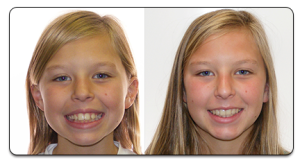This is one of the most common questions that we are asked! In the past, parents were usually told to wait until all of their child’s baby teeth were gone and all of the permanent teeth were in, or to just wait until their dentist told them that it was time to see an orthodontist. However, this has changed over the years.
According to the American Association of Orthodontists, the best age for children to be seen by an orthodontist for the first time is age 7. Why age 7 and what can be done at that age? As you might guess, not every orthodontic problem can be treated at age 7. Surprisingly however, most problems can be identified by that age. Here are a few things that we’ll look for at your child’s first visit.
Crowding: Many of the permanent front teeth are erupting by age 7, so it is often possible to tell if a child has a problem with excessive crowding. Crowding may require that the arches be expanded or that teeth be removed to help resolve the problem.
Spacing: When excessive spacing is present, it may mean that a baby tooth has been lost prematurely, a tooth never developed, or that the teeth are just too small. Sometimes a space maintainer is required to simply hold a space open and prevent other problems from developing.
Crooked teeth: While it is true that teeth can be straightened at an older age, crooked teeth are more susceptible to uneven wear or damage due to trauma, and the shape and position of the overlying gum tissues can be compromised. Crooked teeth can also have social implications that if dealt with at an early age will have less impact on a child’s self-esteem.
Flared front teeth: As the permanent front teeth erupt into the mouth, it becomes obvious if they protrude out farther than is attractive or safe. We can help reduce the severity of the problem and make things easier for young patients both socially and dentally while waiting for the rest of their permanent teeth to erupt.
Underbite: If we see an underbite at an early age, we will recommend trying to at least “jump the bite” at that age even though definitive correction may not be accomplished until a child is in his or her late teens. Although it is best to wait to finish treatment in patients who have underbites until they have finished growing, it is important to try to correct the bite of the front teeth as early as possible to eliminate damage to these teeth due to traumatic occlusion.
Premature tooth loss: Baby (or primary) teeth are lost in a fairly specific order. Deviations from this pattern may indicate that a child has developmental issues that need attention. Between the ages of 6 and 8, it is normal for a child to lose his or her first eight primary incisors. Sometimes removing a primary tooth early or maintaining a space where a primary tooth has been lost prematurely can prevent bigger problems later on.
Proper eruption of teeth: Ideally the eight primary incisors are soon replaced by eight permanent incisors. It also is normal for the child’s first permanent molars to erupt at age 6 (the “6-year molars”). By age 7, children should have at least four permanent molars and four permanent incisors. If there are more or less teeth than this, there may be problems with crowding, missing teeth or extra teeth.
Crossbite: A crossbite is where an upper tooth fits behind a lower tooth. A crossbite of a front tooth can cause a lower tooth to get pushed too far forward resulting in gum recession along the front of that lower tooth. A crossbite of a back tooth or of several back teeth can cause the lower jaw to shift to one side and often results in crowding in the upper jaw. Expanding the upper jaw at age 7 can reduce the crowding and eliminate any shifting of the lower jaw that may be present due to a constricted upper arch.
Deep overbite: Bites where the top teeth completely cover the bottom teeth when biting may indicate that the child has a small lower jaw. Often this problem can be addressed later when most of the permanent teeth are in (age 10 or 11) or in some severe cases a simple “bite plate” retainer is used to minimize the problem until the child is older.
Openbite: Bites that don’t overlap enough may indicate that there is a tongue thrust or a finger or thumb sucking habit that may be causing the problem. We recommend eliminating these destructive habits early so that normal development can occur.
We recommend evaluating all children at age 7 so that these and other conditions can be identified and corrected as early as possible. Although most children will be able to wait until all of their the permanent teeth are in, interceptive orthodontic treatment oftentimes can make the final results better and give your child an additional three to four years of having a great smile at an age when his or her self-image is developing.
By Gary Reichhold, DDS
NOV


About the Author:
Dr. Gary Reichhold and his partner Dr. Stephen Tanner have been proudly serving families in Concord, Walnut Creek, Clayton, Pleasant Hill and the surrounding communities for over 20 years. Their office is conveniently located in central Contra Costa County and their experienced team is committed to providing you and your family with exceptional orthodontic care.